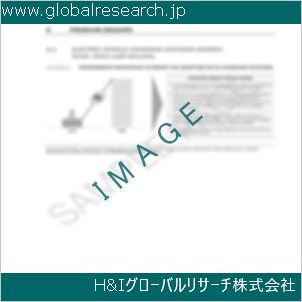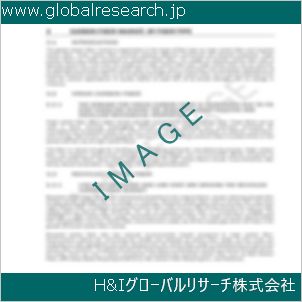Table of Contents
1 Industry Overview of Bariumsulfide
1.1 Definition and Specifications of Bariumsulfide
1.1.1 Definition of Bariumsulfide
1.1.2 Specifications of Bariumsulfide
1.2 Classification of Bariumsulfide
1.3 Applications of Bariumsulfide
1.3.1 Nuclear Application
1.3.2 Non-Nuclear Application
1.4 Industry Chain Structure of Bariumsulfide
1.5 Industry Overview and Major Regions Status of Bariumsulfide
1.5.1 Industry Overview of Bariumsulfide
1.5.2 Global Major Regions Status of Bariumsulfide
1.6 Industry Policy Analysis of Bariumsulfide
1.7 Industry News Analysis of Bariumsulfide
2 Manufacturing Cost Structure Analysis of Bariumsulfide
2.1 Raw Material Suppliers and Price Analysis of Bariumsulfide
2.2 Equipment Suppliers and Price Analysis of Bariumsulfide
2.3 Labor Cost Analysis of Bariumsulfide
2.4 Other Costs Analysis of Bariumsulfide
2.5 Manufacturing Cost Structure Analysis of Bariumsulfide
2.6 Manufacturing Process Analysis of Bariumsulfide
3 Technical Data and Manufacturing Plants Analysis of Bariumsulfide
3.1 Capacity and Commercial Production Date of Global Bariumsulfide Major Manufacturers in 2023
3.2 Manufacturing Plants Distribution of Global Bariumsulfide Major Manufacturers in 2023
3.3 R&D Status and Technology Source of Global Bariumsulfide Major Manufacturers in 2023
3.4 Raw Materials Sources Analysis of Global Bariumsulfide Major Manufacturers in 2023
4 Capacity, Production and Revenue Analysis of Bariumsulfide by Regions, Types and Manufacturers
4.1 Global Capacity, Production and Revenue of Bariumsulfide by Regions 2019-2024
4.2 Global and Major Regions Capacity, Production, Revenue and Growth Rate of Bariumsulfide 2019-2024
4.3 Global Capacity, Production and Revenue of Bariumsulfide by Types 2019-2024
4.4 Global Capacity, Production and Revenue of Bariumsulfide by Manufacturers 2019-2024
5 Price, Cost, Gross and Gross Margin Analysis of Bariumsulfide by Regions, Types and Manufacturers
5.1 Price, Cost, Gross and Gross Margin Analysis of Bariumsulfide by Regions 2019-2024
5.2 Price, Cost, Gross and Gross Margin Analysis of Bariumsulfide by Types 2019-2024
5.3 Price, Cost, Gross and Gross Margin Analysis of Bariumsulfide by Manufacturers 2019-2024
6 Consumption Volume, Consumption Value and Sale Price Analysis of Bariumsulfide by Regions, Types and Applications
6.1 Global Consumption Volume and Consumption Value of Bariumsulfide by Regions 2019-2024
6.2 Global and Major Regions Consumption Volume, Consumption Value and Growth Rate of Bariumsulfide 2019-2024
6.3 Global Consumption Volume and Consumption Value of Bariumsulfide by Types 2019-2024
6.4 Global Consumption Volume and Consumption Value of Bariumsulfide by Applications 2019-2024
6.5 Sale Price of Bariumsulfide by Regions 2019-2024
6.6 Sale Price of Bariumsulfide by Types 2019-2024
6.7 Sale Price of Bariumsulfide by Applications 2019-2024
6.8 Market Share Analysis of Bariumsulfide by Different Sale Price Levels
7 Supply, Import, Export and Consumption Analysis of Bariumsulfide
7.1 Supply, Consumption and Gap of Bariumsulfide 2019-2024
7.2 Global Capacity, Production, Price, Cost, Revenue, Supply, Import, Export and Consumption of Bariumsulfide 2019-2024
7.3 USA Capacity, Production, Price, Cost, Revenue, Supply, Import, Export and Consumption of Bariumsulfide 2019-2024
7.4 EU Capacity, Production, Price, Cost, Revenue, Supply, Import, Export and Consumption of Bariumsulfide 2019-2024
7.5 China Capacity, Production, Price, Cost, Revenue, Supply, Import, Export and Consumption of Bariumsulfide 2019-2024
7.6 Japan Capacity, Production, Price, Cost, Revenue, Supply, Import, Export and Consumption of Bariumsulfide 2019-2024
8 Major Manufacturers Analysis of Bariumsulfide
8.1 Manufacturer One
8.1.1 Company Profile
8.1.2 Product Picture and Specifications
8.1.2.1 Type I
8.1.2.2 Type II
8.1.2.3 Type III
8.1.3 Capacity, Production, Price, Cost, Gross and Revenue
8.1.4 Contact Information
8.2 Manufacturer Two
8.2.1 Company Profile
8.2.2 Product Picture and Specifications
8.2.2.1 Type I
8.2.2.2 Type II
8.2.2.3 Type III
8.2.3 Capacity, Production, Price, Cost, Gross and Revenue
8.2.4 Contact Information
8.3 Manufacturer Three
8.3.1 Company Profile
8.3.2 Product Picture and Specifications
8.3.2.1 Type I
8.3.2.2 Type II
8.3.2.3 Type III
8.3.3 Capacity, Production, Price, Cost, Gross and Revenue
8.3.4 Contact Information
8.4 Manufacturer Four
8.4.1 Company Profile
8.4.2 Product Picture and Specifications
8.4.2.1 Type I
8.4.2.2 Type II
8.4.2.3 Type III
8.4.3 Capacity, Production, Price, Cost, Gross and Revenue
8.4.4 Contact Information
8.5 Manufacturer Five
8.5.1 Company Profile
8.5.2 Product Picture and Specifications
8.5.2.1 Type I
8.5.2.2 Type II
8.5.2.3 Type III
8.5.3 Capacity, Production, Price, Cost, Gross and Revenue
8.5.4 Contact Information
…
9 Marketing Trader or Distributor Analysis of Bariumsulfide
9.1 Marketing Channels Status of Bariumsulfide
9.2 Traders or Distributors with Contact Information of Bariumsulfide by Regions
9.3 Ex-work Price, Channel Price and End Buyer Price Analysis of Bariumsulfide
9.4 Regional Import, Export and Trade Analysis of Bariumsulfide
10 Industry Chain Analysis of Bariumsulfide
10.1 Upstream Major Raw Materials Suppliers Analysis of Bariumsulfide
10.1.1 Major Raw Materials Suppliers with Contact Information Analysis of Bariumsulfide
10.1.2 Major Raw Materials Suppliers with Supply Volume Analysis of Bariumsulfide by Regions
10.2 Upstream Major Equipment Suppliers Analysis of Bariumsulfide
10.2.1 Major Equipment Suppliers with Contact Information Analysis of Bariumsulfide
10.2.2 Major Equipment Suppliers with Product Pictures Analysis of Bariumsulfide by Regions
10.3 Downstream Major Consumers Analysis of Bariumsulfide
10.3.1 Major Consumers with Contact Information Analysis of Bariumsulfide
10.3.2 Major Consumers with Consumption Volume Analysis of Bariumsulfide by Regions
10.4 Supply Chain Relationship Analysis of Bariumsulfide
11 Development Trend of Analysis of Bariumsulfide
11.1 Capacity, Production and Revenue Forecast of Bariumsulfide by Regions and Types
11.1.1 Global Capacity, Production and Revenue of Bariumsulfide by Regions 2024-2029
11.1.2 Global and Major Regions Capacity, Production, Revenue and Growth Rate of Bariumsulfide 2024-2029
11.1.3 Global Capacity, Production and Revenue of Bariumsulfide by Types 2024-2029
11.2 Consumption Volume and Consumption Value Forecast of Bariumsulfide by Regions, Types and Applications
11.2.1 Global Consumption Volume and Consumption Value of Bariumsulfide by Regions 2024-2029
11.2.2 Global and Major Regions Consumption Volume, Consumption Value and Growth Rate of Bariumsulfide 2024-2029
11.2.3 Global Consumption Volume and Consumption Value of Bariumsulfide by Types 2024-2029
11.2.4 Global Consumption Volume and Consumption Value of Bariumsulfide by Applications 2024-2029
11.3 Supply, Import, Export and Consumption Forecast of Bariumsulfide
11.3.1 Supply, Consumption and Gap of Bariumsulfide 2024-2029
11.3.2 Global Capacity, Production, Price, Cost, Revenue, Supply, Import, Export and Consumption of Bariumsulfide 2024-2029
11.3.3 USA Capacity, Production, Price, Cost, Revenue, Supply, Import, Export and Consumption of Bariumsulfide 2024-2029
11.3.4 EU Capacity, Production, Price, Cost, Revenue, Supply, Import, Export and Consumption of Bariumsulfide 2024-2029
11.3.5 China Capacity, Production, Price, Cost, Revenue, Supply, Import, Export and Consumption of Bariumsulfide 2024-2029
11.3.6 Japan Capacity, Production, Price, Cost, Revenue, Supply, Import, Export and Consumption of Bariumsulfide 2024-2029
12 New Project Investment Feasibility Analysis of Bariumsulfide
12.1 New Project SWOT Analysis of Bariumsulfide
12.2 New Project Investment Feasibility Analysis of Bariumsulfide
13 Conclusion of the Global Bariumsulfide (CAS 21109-95-5) Industry 2024 Market Research Report
| ※参考情報 硫化バリウム(Bariumsulfide)は、化学式 BaS で表される無機化合物であり、バリウムの硫化物の一つです。CAS登録番号は21109-95-5です。硫化バリウムは白色から淡黄色の結晶または粉末状の物質で、水に溶けませんが、酸や酸化剤には反応を示します。以下に硫化バリウムの定義や特徴、種類、用途、関連技術について詳しく説明いたします。 まず、硫化バリウムの基本的な定義を見てみましょう。この物質は、バリウムイオン(Ba²⁺)と硫化物イオン(S²⁻)から構成されるイオン結晶で、イオン結合により結びついています。結晶構造は立方体であり、その安定した結晶性は、固体状態での利用において重要な特性となります。 硫化バリウムの特徴としては、まずその化学的性質が挙げられます。硫化バリウムは高い水溶性を持たず、アルカリ金属の硫化物と比較すると、耐水性が高いという特性があります。また、強酸に対しては反応し、バリウムイオンと硫酸イオンに分解される場合があります。この性質は、硫化バリウムを利用する際の注意点とされています。 さらに、硫化バリウムは還元剤としての特性を持ち、化学反応において還元剤として使用されることがあります。これにより、硫化バリウムはさまざまな化学合成の過程で重要な役割を果たすことができます。また、硫化バリウムは生体内ではあまり存在しないため、環境中の毒性評価においても注目されることがあります。 次に、硫化バリウムの種類についてですが、一般的には純度や結晶形の違いによって分類されることがあります。純粋な硫化バリウムは主に工業用途に使用されますが、他の元素と混合された合金材料や、特定の化学合成における中間体としての形態もあります。また、硫化バリウムはその性質を応用して製造される各種溶液としても利用されることがあります。 硫化バリウムの用途は非常に広範囲にわたります。まず、硫化バリウムは蛍光材料や顔料の製造において重要な役割を担っています。特に、バリウムが含まれる化合物が蛍光特性を持つため、ディスプレイや照明装置の材料として利用されることがあります。また、バリウム系の顔料はカラーコーティングやプラスチック加工に使用されることもあります。 さらに、硫化バリウムは化学産業において触媒や中間体としての用途もあります。特に、金属の還元反応においては硫化バリウムが効果的に機能することがあります。また、分析化学の領域では、硫化バリウムを用いた定性的および定量的な分析方法が用いられています。 そして、硫化バリウムは医療分野でも探求されている物質であり、特に画像診断に関連した用途が期待されています。バリウムを含む化合物は、消化器系の診断において使用されることがあり、その際に硫化バリウムが導入されることがあります。高い密度により、X線撮影に対してコントラストを提供し、内部構造の可視化に役立ちます。 関連技術についても述べます。硫化バリウムに関する研究は、環境科学や材料科学、化学工業など多岐にわたりました。特に環境におけるバリウムの挙動や他の化合物との相互作用についての研究が進められています。これにより、環境中での硫化バリウムの挙動や体に与える影響を理解するための重要な知見が得られています。 また、硫化バリウムの製造プロセスも技術的に進化しており、より効率的で環境負荷の少ない方法が模索されています。従来の化学反応を基にした製造方法に加えて、革新的な材料科学やプロセス技術の導入が進んでおり、新たな用途を開発するための研究も行われています。 以上のように、硫化バリウムには多くの特徴とさまざまな用途が存在します。これに関連する技術や研究も進んでおり、今後の展開が期待されています。また、環境や健康に対する影響についても留意しながら、有効かつ安全な利用方法が確立されることが求められています。 |
❖ 免責事項 ❖
http://www.globalresearch.jp/disclaimer












